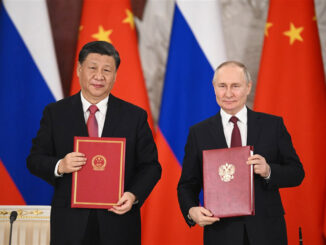
Why China‘s military shouldn’t scare the United States.
On March 5, at the opening of the National People’s Congress, Beijing announced its official 2013 defense budget: roughly $114.3 billion, a 10.7 percent increase over the previous year and, in nominal terms, nearly four times the official budget a decade ago. This level of spending is enough to make China a force in its neighborhood, but not one to engage in combat overseas. Beijing has long faced a much more problematic geostrategic position than Washington has. The United States borders two friendly neighbors and is buffered by massive oceans to its east and west.
It enjoys abundant natural resources and the most allies in the world. China, by contrast, borders 14 countries (including four states with nuclear weapons) and has ongoing disputes with all its maritime neighbors, including its powerful rival, Japan. Since the early 1990s, China has been surprisingly forthright about the reasons it is strengthening its military: to catch up with other powers, to construct a more capable and modern military force in order to assert its outstanding territorial and maritime claims, and to secure its development on its own terms. It also wants to acquire prestige as a full-fledged “military great power” — a status its leaders appear to increasingly see as necessary to enhance China’s international standing. Despite technological inferiority through most of the last two decades, the People’s Liberation Army (PLA) utilized its geographical proximity to potential hot spots in what it calls the “Near Seas” (the Yellow, East China, and South China seas) to develop deterrents based on asymmetric technologies aimed at exploiting the vulnerabilities in potential adversaries’ expensive military technologies.
China’s ballistic and cruise missiles, for example, are cheaper to produce, deploy, and use to attack enemy surface ships than the defensive systems necessary to protect would-be targets. In short, China is increasing the potential cost for the United States to intervene in the Near Seas. Beijing is still spending well within its means. Its defense budget is the world’s second-largest, but so is its economy. China’s military-spending growth is roughly consistent with its rising GDP and is actually outpaced by Beijing’s rapid increase in state financial expenditures.
China is no Soviet Union, whose military spending ultimately stunted its economy, reaching unsustainable levels — far higher proportionally than that of China today, even when compared with high-end estimates of Beijing’s actual spending. China’s official defense budget still doesn’t capture all defense-related spending, but no country’s does.
U.S. spending on nuclear weapons, as well as the hundreds of billions of dollars in supplemental appropriations that George W. Bush’s administration used to fund operations in Iraq, doesn’t appear in the official Pentagon budget. U.S. defense-related spending appears clearly in other official documents, but the same is true for at least one major item China excludes from its defense budget: spending on its paramilitary force, the People’s Armed Police, which is published in annual statistical yearbooks — albeit without significant details — under “Public Security.” Although China’s official budget figure remains far less transparent than Pentagon spending, it appears increasingly accurate. The U.S. Defense Department estimates that China’s “total military-related spending” in relation to Beijing’s official defense-budget figure has fallen from approximately 325 to 400 percent of official figures for 2002, to 143 to 214 percent for 2008, to 113 to 170 percent for 2011 — a significant trend in Chinese budget transparency. Meanwhile, the United States is convulsed by debate over whether it can afford to maintain current defensespending levels.
In China, however, rapid economic and tax-revenue growth has provided a rising budgetary tide, allowing Chinese leaders the luxury of avoiding many tough decisions about spending priorities. And there’s no end in sight: The U.S. National Intelligence Council predicts that China’s GDP will surpass that of the United States in purchasing-power-parity terms in 2022, and near 2030 at market exchange rates, suggesting that high defense spending may be sustainable for a long time.





Be the first to comment